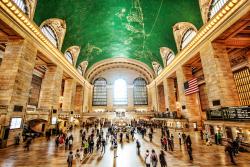
Spearheaded by Chief Engineer William J. Wilgus and constructed under challenging conditions with no interruption of existing train service, Grand Central Terminal was a triumph of innovative engineering in the design of urban transportation centers. Its novel, two-level station, made possible by electric traction, streamlined both train and passenger movement by separating long-haul and suburban traffic and employing an extensive system of pedestrian ramps throughout the facility. With the tracks and platforms below grade, the lease of "air rights" for over twenty five overhead buildings helped fund the project.
By the turn of the 20th century, public concern about steam locomotive safety was on the rise and noise and air pollution were chronic. A catastrophic train collision on January 8, 1902 in the smoke-filled Park Avenue Tunnel killed seventeen and injured thirty-eight, causing a public outcry and increasing demand for electric trains. By the end of the year, plans were in development to demolish Grand Central Station and create a new double level terminal for electric trains.
Construction would last ten years, yet in spite of the upheaval, rail service continued uninterrupted. Excavation was an enormous undertaking as the grade of the rail yard was lowered to an average depth of 30 feet below street level. Trains removing excavated material and delivering construction supplies had to be scheduled so as not to interfere with the 75,000 to 100,000 daily passengers. Spoil material was transported up to 40 miles away and dumped into the Hudson River to widen the railroad's right-of-way for the creation of a train yard at Croton-on-Hudson.
Grand Central Terminal produced annual revenue for the railroad and project financing by selling air rights above the station, serving as a model for the development of air rights above other railroad stations. The project served as the catalyst and anchor for a civic center within Manhattan as development above the rail yards restored the street grid and opened up thirty city blocks.
Grand Central Terminal was the first terminal station to use ramps on a great scale, largely eliminating staircases from its design. Entrances and exits were spaced apart so they would not interfere with each other during times of heavy crowding. The design included a then-innovative baggage handling facility that eliminated the conflicts experienced at other train stations where both passengers and baggage were loaded and unloaded at the same location on platforms, pioneering a system that is commonplace at modern rail and air transportation hubs.
Central Terminal officially opened to great fanfare at 12:01 am on Sunday, February 2, 1913, and more than 150,000 people visited the new terminal on its opening day. Although construction was not yet entirely complete, Grand Central Terminal had arrived and New York City would never be the same again.


